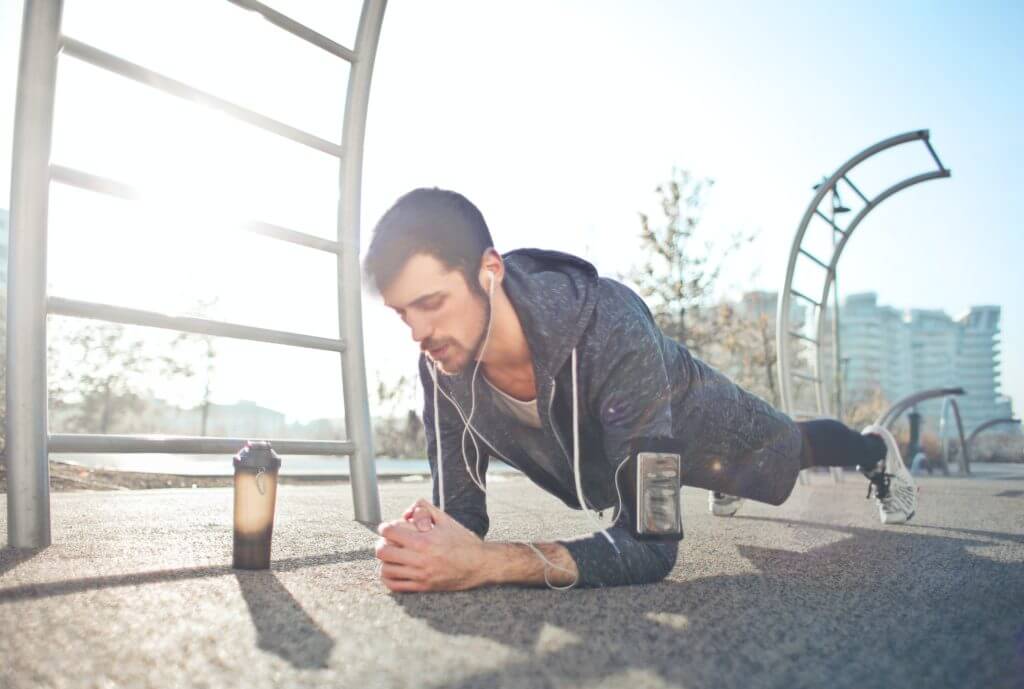CANTERBURY, United Kingdom — Exercises that engage and tire out muscle groups without actually moving, like planks or wall sits, appear to be best when it comes to lowering one’s blood pressure. Scientists from Canterbury Christ Church University and the University of Leicester have found that static isometric exercises can help with hypertension more than any other workout.
However, the new study also notes many other forms of exercise are pretty helpful too when it comes to hypertension. The findings indicate cardio’ (aerobic exercise), dynamic resistance training like squats, press-ups, and weights, and high-intensity interval training or HIIT (episodic short bouts of high-intensity exercise interspersed with short periods of recovery) are all effective to varying degrees as well.
In light of this work, study authors believe it may be time to review the current exercise guidelines for the prevention and treatment of high blood pressure. Prior research shows that working out in general has a link to significant reductions in blood pressure. In most cases, exercises including cardio (walking, running, and cycling) are recommended to manage blood pressure.
This recommendation, however, is based on old data that doesn’t account for newer forms of exercise like HIIT and isometric exercise. Thus, current guidelines may be outdated.

So, to update the available information on the best form of exercise for controlling blood pressure, researchers searched through numerous databases looking for clinical trials examining the effects of an exercise training intervention lasting two or more weeks on resting blood pressure. Exercise interventions were classified as aerobic (cardio), dynamic resistance training, a combination of these, HIIT, or isometric exercises.
Study authors defined healthy resting blood pressure as any reading below 130/85 mmHg, pre-high blood pressure as 130–139/85–89 mmHg, and high blood pressure as 140/90 mmHg or more. Systolic blood pressure (the first or top number in a reading) is critical because it measures the arterial pressure when the heart beats. Diastolic blood pressure, the second or bottom number, measures arterial pressure between beats.
All in all, the review featured 270 randomized controlled trials published between 1990 and February 2023, which utilized a data sample totaling 15,827 participants.
The pooled data analysis found notable reductions in resting systolic and diastolic blood pressure after all categories of exercise. However, the most significant drops in both systolic and diastolic blood pressure came after isometric exercise training.
Blood pressure reductions after aerobic exercise training amounted to 4.49/ 2.53 mmHg, 4.55/3.04 mm Hg after dynamic resistance training, 6.04/2.54 mmHg after combined training, 4.08/2.50 mmHg after HIIT, and 8.24/4 mmHg after isometric exercise training.
Order of effectiveness values for reducing systolic blood pressure, meanwhile, came in at isometric exercise training (98%), combined training (76%), dynamic resistance training (46%), aerobic exercise training (40.5%), and HIIT (39%).

A round of secondary analyses revealed wall squats (isometric) and running (aerobic) appear to be the most effective individual exercises when it comes to lowering systolic blood pressure (90.5%) and diastolic blood pressure (91%), respectively. Isometric exercise, overall, seems to be the most effective for reducing both blood pressure elements.
Study authors acknowledge that variations in the types of participants across included clinical trials, as well as differences in statistical and methodological processes and exercise interventions, may have influenced these results. Thus, this work should be interpreted in light of these limitations.
“Overall, isometric exercise training is the most effective mode in reducing both systolic and diastolic blood pressure,” the study authors write in a media release.
“These findings provide a comprehensive data driven framework to support the development of new exercise guideline recommendations for the prevention and treatment of arterial hypertension.”
The study is published in the British Journal of Sports Medicine.
You might also be interested in:
- Best Core Exercises: Top 5 Moves To Build Your Abs, According To Experts
- Why six-pack abs are so hard to achieve – and maintain
- High blood pressure in your 30s could lead to dementia in your 70s


Perhaps passive isometrics where gravity is the resistance, like wall sits, is a BP reducer. But isometrics where you push or exert against , say, a wall, is a huge, documented danger to those with hypertension. Your headline is quite misleading, IMO